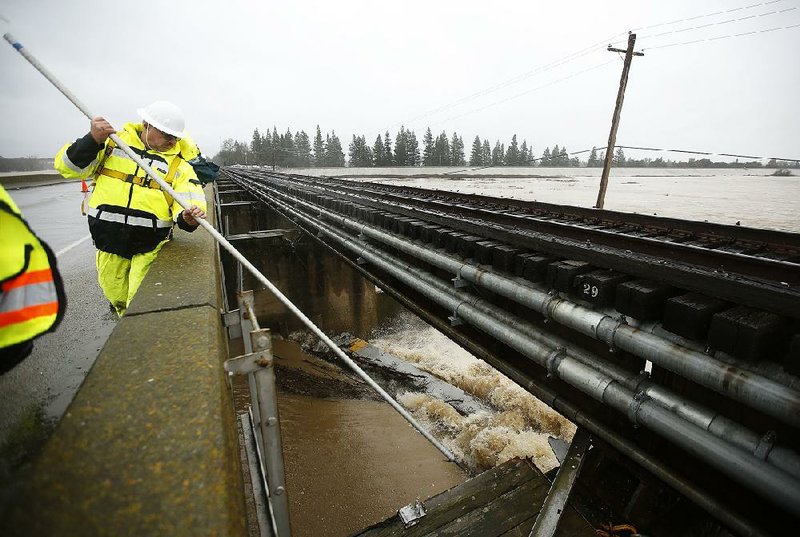GUERNEVILLE, Calif. -- Authorities asked thousands to flee a rural Northern California community where floodwaters Tuesday threatened to burst over an overwhelmed levee as four days of storms delivered the heaviest rain and snow in years and locked the Sierra Nevada mountains in a rare blizzard.
Emergency crews and officials worked through Tuesday to try to bolster the levee in Sacramento County along the Cosumnes River, before deciding to ask 2,000 residents of Wilton to voluntarily evacuate before dark.
Sacramento County emergency services official Mary Jo Flynn said water was expected to spill over the levee before midnight, covering low-lying roads and buildings with up to 1 foot of floodwater.
In the city of Sacramento, workers wrenched open more than a half-dozen century-old spill gates on the state's biggest river, the Sacramento, on Tuesday to ease pressure on the swollen river and on levees there.
[INTERACTIVE: Map of California, Nevada flooding after storm]
Some 3,000 Sonoma County residents remained under an evacuation order as the Russian River rose again under pounding rain. Officials red-tagged seven homes, ordering residents out, when a rain-soaked embankment crashed down.
Johna Peterson was one of a few people who ventured out in the remote Sonoma County town of Monte Rio. Walking on the bridge across the Russian River, Peterson worried about the coming hours and days.
"I think it's going to go higher," Peterson said. "There's nowhere for this water to go."
In nearby Forestville, Kathy Granados huddled with two other people under an awning at the River Bend RV Park, watching the downpour.
"We're waiting it out," she said. "Yesterday the water dropped, but it's going to get higher. We're just sitting here. We have no electricity, no heat."
Tuesday's storm was the latest of back-to-back systems -- buffered by a brief respite Monday -- that have spawned the heaviest rain in a decade to parts of Northern California and Nevada.
The storms are part of an "atmospheric river" weather phenomenon that draws precipitation from the Pacific Ocean as far west as Hawaii.
A blizzard warning was in effect for parts of the Sierra Nevada, the first issued in the past nine years, said Scott McGuire, a forecaster for the National Weather Service in Reno, Nev.
"This is definitely a dangerous, life-threatening situation going on up there," he said. "People should not attempt to travel at all."
Forecasters warned of up to 10 feet of snow in the highest mountains, with up to 7 feet around the resorts of Lake Tahoe, high risk of avalanches, and wind gusts to 60 mph. The Sierra ridge had gusts of more than 100 mph.
Many ski resorts shut down Tuesday because of the storm. Several main roads in the Sierra were closed, including Interstate 80, or required chains.
Nearly 3 feet of new snow already was reported Tuesday morning at the top of the Mount Rose ski resort between Reno and Lake Tahoe. Previous storms had added 33 billion gallons of water to Lake Tahoe since Jan. 1.
Some operations, however, returned to normal.
Yosemite National Park reopened the valley floor to visitors Tuesday morning after a plump river forced it to shut down over the weekend.
And the opening of the century-old spill gates in Sacramento marked a historic event.
California is in a six-year drought, and the last time state workers needed to open the gates by hand to spill water into side channels was December 2005.
"They were a little bit rusty," department spokesman Ted Thomas said, "but they were able to open them fine."
Information for this article was contributed by Ellen Knickmeyer, Olga Rodriguez, and Jocelyn Gecker in San Francisco and Scott Sonner of The Associated Press.
A Section on 01/11/2017
